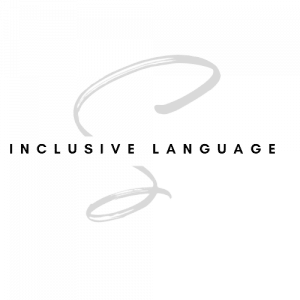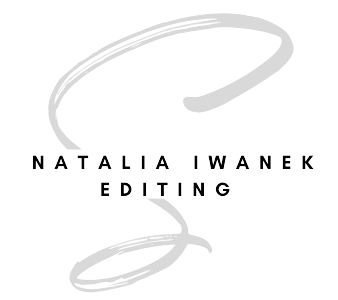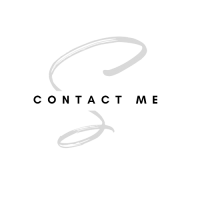Inclusive Language
In recent years, editors and writers have begun paying particular attention to terminology that may cause unintentional harm to their audience. This focus has developed into what is known known as inclusive language.
Particularly, inclusive language focuses on ensuring respectful and equitable representation of equity-deserving communities when writing and editing text. This means adhering to best practices and ever-evolving terminology.
Closely related, conscious language focuses on choosing terminology intentionally. Coined by Karen Yin, creator of the Conscious Style Guide, conscious language is “language that is rooted in critical thinking and compassion, used skillfully in a specific context.”

Benefits of Inclusive Language
Although inclusive language has many benefits, it can be summed up in four main points.
Inclusive Language
- avoids the unintentional use of outdated, harmful, and/or dehumanizing terminology,
- avoids the use of harmful stereotypes and tropes,
- deconstructs unconscious/implicit biases, and
- fosters a sense of inclusion and equity.
Specifically, it allows you to offer the best possible reading experience for your target audience.

My Background in Inclusive Language
My experience and training in conscious language, plain language, accessibility, as well as Inclusion, Diversity, Equity, and Accessibility (IDEA) and Equity, Diversity, and Inclusion (EDI) principles is extensive and ongoing.
Surely, you may be wondering why I chose this particular path.
Well, a detailed response would require several hours of conversation!
However, briefly, I can say that my main reason is my personal lived experience.
Specifically, I grew up multi-lingual in various geographical locations and, to this day, very much enjoy the nuances and evolution of language and terminology. In addition, as a member of several equity-deserving communities myself, I understand that language is never neutral and carefully consider style choices when editing and writing.
For this reason, I will treat your manuscript or document with empathy and care, while offering suggestions based on inclusive language principles and best practices. This will ensure that your audience has the best possible experience when reading your work.
Finally, please note that while I offer a general language overview, my specializations are disability, queerness, and the intersections of disability and queerness.
Questions or comments? Please do not hesitate to reach out anytime to discuss your project, my editor background, or to ask for further clarification! I look forward to connecting! – Natalia
Inclusion, Diversity, Equity, and Accessibility (IDEA): Education
- Editing Certificate – Simon Fraser University. Burnaby, British Columbia
- Plain Language Certificate – Simon Fraser University. Burnaby, British Columbia
IDEA Certificates
- Editing for Conscious and Inclusive Language Certificate – Editorial Freelancers Association (EFA) – 2024
- How to Host Accessible Events Certificate – Accessibility Services Canada – 2023
- Basics of Inclusive Design for Online Education – Coursera: University of Colorado Boulder – 2023
- An Introduction to Accessibility and Inclusive Design – Coursera: University of Illinois at Urbana-Champaign – 2023
- Disability Awareness and Support – Coursera: University of Pittsburgh – 2023
- Introduction to Gender-Based Analysis+ Certificate – Government of Canada: Department of Women and Gender Equity – 2022
- Indigenous Canada Certificate. Coursera: The University of Alberta – 2022
IDEA Editing-Specific Webinars
- Some of the Things You Wanted to Know about Alt Text – Editors Canada (Amber Riaz) 2023
- An Editor’s Guide to Assessing and Addressing Problematic Content – ACES: The Society for Editing (Crystal Shelley) 2023
- Tips for Editing Genres That Include Violence, Suicide and Mental Illness – ACES: The Society for Editing (Karin Cather) 2023
- Gender-Inclusive Editing: Becoming a Radical Editor – Editors Toronto (Alex Kapitan) 2022
- Editing Indigenous Content: The Importance of Cultural Sensitivity and Respect – Editors Toronto (Kaitlin Littlechild) 2022
- Balancing Cultural Sensitivity with Craft – Editors Toronto (Sangeeta Netha) 2021
- Trauma-Informed Editing – Editors Transform: Editors Canada Conference (Iva Cheung) 2021
- Microaggressions in Editing: Understanding Bias and Undoing Harm – ACES:The Society for Editing (Crystal Shelley) 2021
Inclusion, Diversity, Equity, and Accessibility (IDEA) Training
- Celebrating and Elevating 2SLGBTQIA Communities – Canadian Centre for Diversity and Inclusion (CCDI) 2023
- Queer 101 Training – OUTReach Southern Alberta 2023
- Fundamentals of Anti-Oppression – Bakau Consulting 2023
- Disrupting Unconscious Bias – Bakau Consulting 2022
- All the T: Gender Within the 2SLGBTQIA+ Communities – CCDI 2022
- Reconciling Identity: A Discussion about Two-Spirit People Within the LGBTTQ2+ Communities – CCDI 2022
- Diversity, Equity, and Inclusion Fundamentals – CCDI 2022
- Evolution of DEI Language – CCDI 2022
- The Intersections of Identity: A Discussion About the Intersection of Race, Ethnicity, Sexuality, and Gender – CCDI 2022
- Microagressions and Microinterventions: The Macro of the Micro – CCDI 2022
- How Workplaces Can Respond to Tragic News and Events: A Panel – CCDI 2022
- Diversity and Inclusion 101: Practice Initiative You Can Start Today – CCDI 2021
- Intersectionality in the Workplace – CCDI 2021
- Creating Effective D&I Councils and Committees – CCDI 2021
- Indigenous Inclusion 2.0 – CCDI 2021
Inclusive Language Services
- Please note that all my editing services include general inclusive language feedback and suggestions.
- Choosing the Inclusive Language Edit or the Inclusive Language Style Guide option specifically ensures a detailed focus on inclusive language, as well as a separate and detailed feedback report.
- While I offer a general inclusive language overview, my specializations are disability, queerness, and the intersections of disability and queerness.
- Finally, rates depend on project requirements.
Option 1: Inclusive Language Edit – Before we begin, we will agree upon the type of edit your document requires. This could be a copy edit, stylistic edit, or a combination of both.
This type of edit includes
- an email discussion of your editing needs and project specifics,
- one round of copy or stylistic (or copy/stylistic) editing,
- one round of inclusive language editing, and
- a follow up email discussion regarding any clarifications or questions.
At our agreed upon due date, I will provide you with
- a (copy, stylistically, or copy/stylistically) edited document (either a Microsoft Word document with “Track Changes” and comments or a Google document with “Suggested” edits and comments),
- an extensive inclusive language edit,
- a list of recommended inclusive language resources,
- a clean Microsoft Word or Google document,
- a one-page summary of my editing and inclusive language suggestions, and
- a style sheet of my edits.
Option 2: Inclusive Style Guide – In the second option, I will create an inclusive language style guide for you or your organization to follow. This will be a “living document,” which can be edited over the years, as terminology evolves.
At our agreed upon due date, I will provide you with
- an extensive inclusive language style guide in the form of a Microsoft Word document or a Google document and
- an extensive list of inclusive language resources.
Inclusive Language Terms and Conditions
- All prices are quotes in CAD.
- Upon receipt of documents, a contract will be sent to the Client, which must be signed prior to commencing work.
- This contract will establish scope of work, expectations, and timelines.
- A 50% deposit must be sent via e-transfer or PayPal prior to the Editor commencing work.
- The remaining 50% will be due within 10 days of completed work and receipt of Editor invoice.

